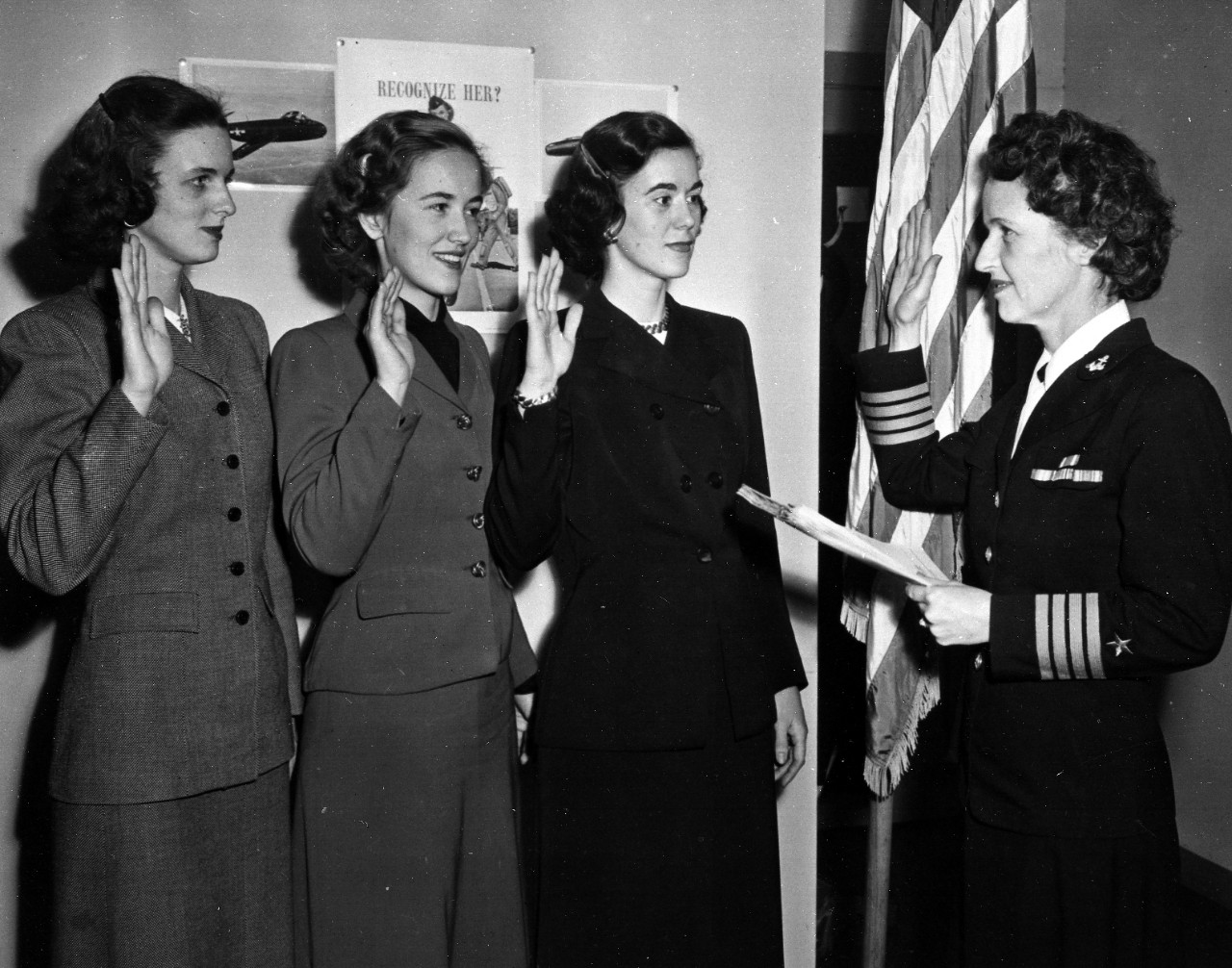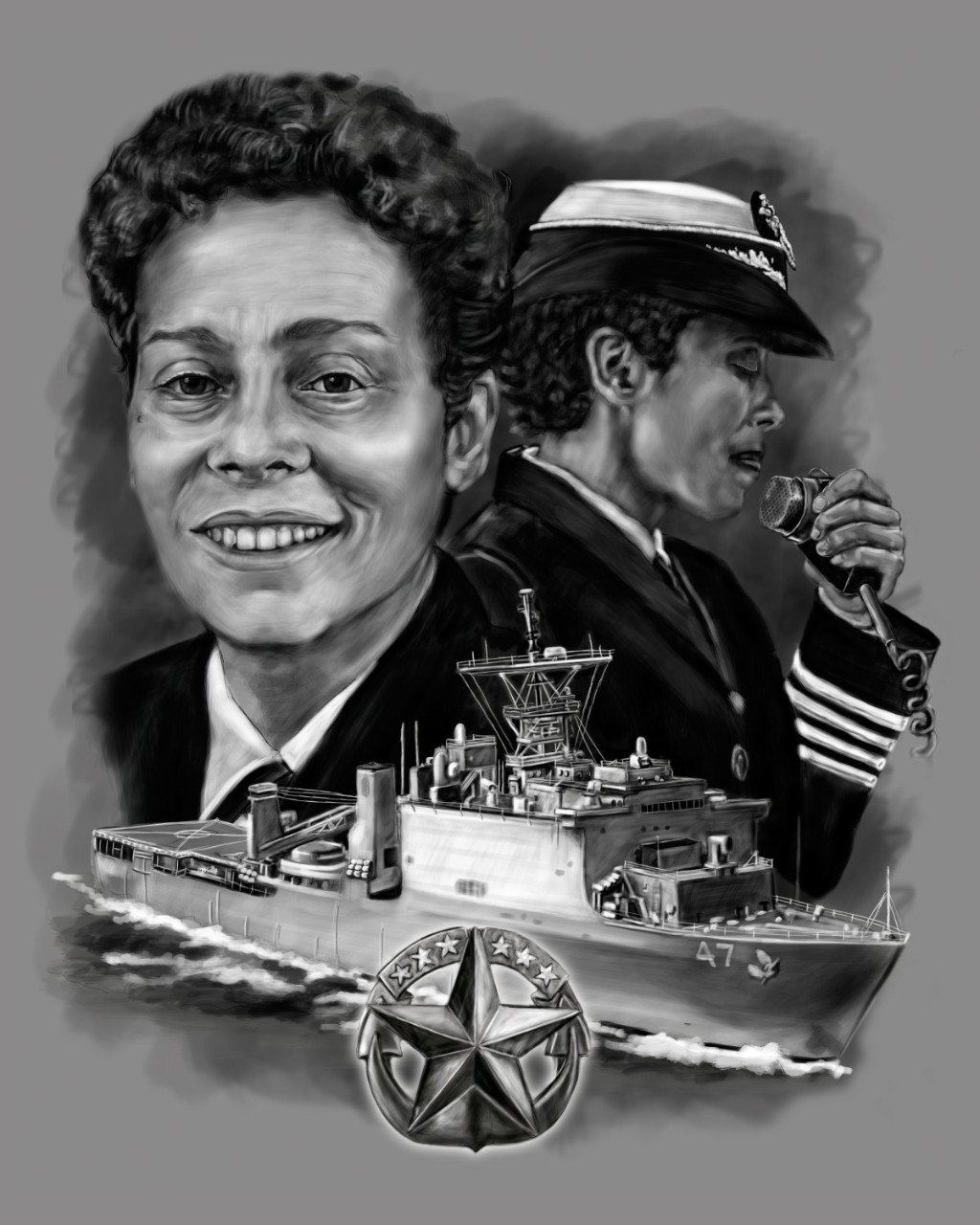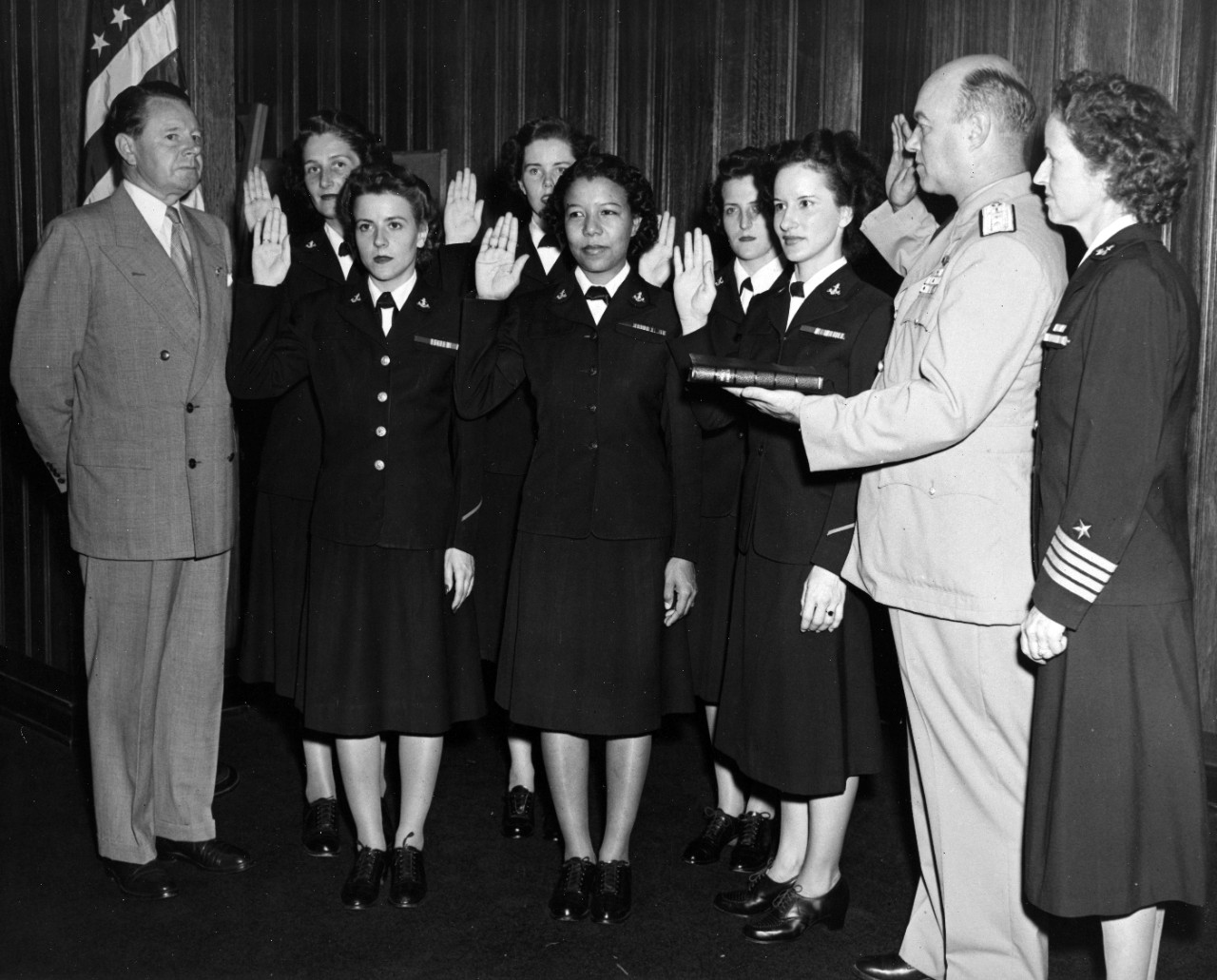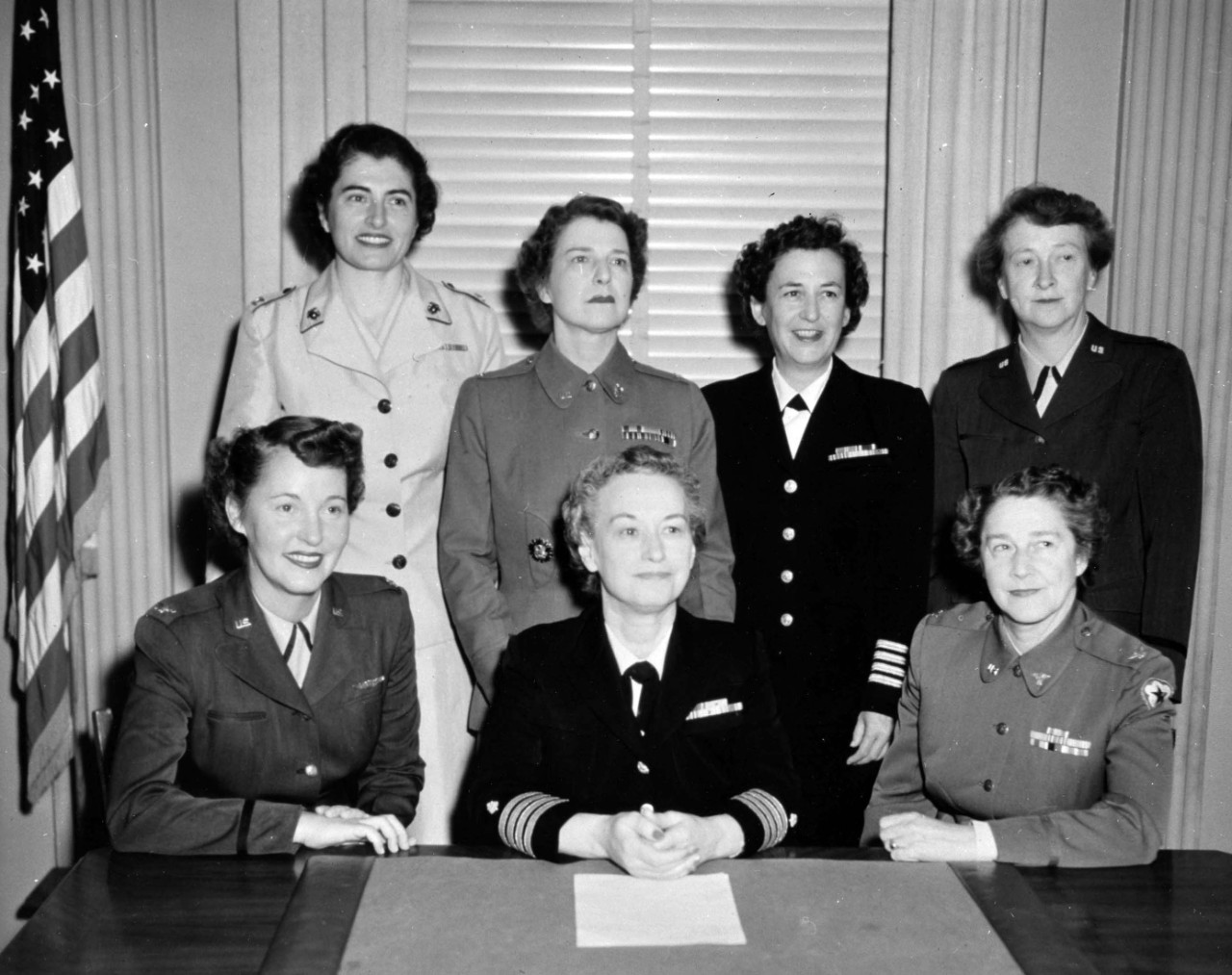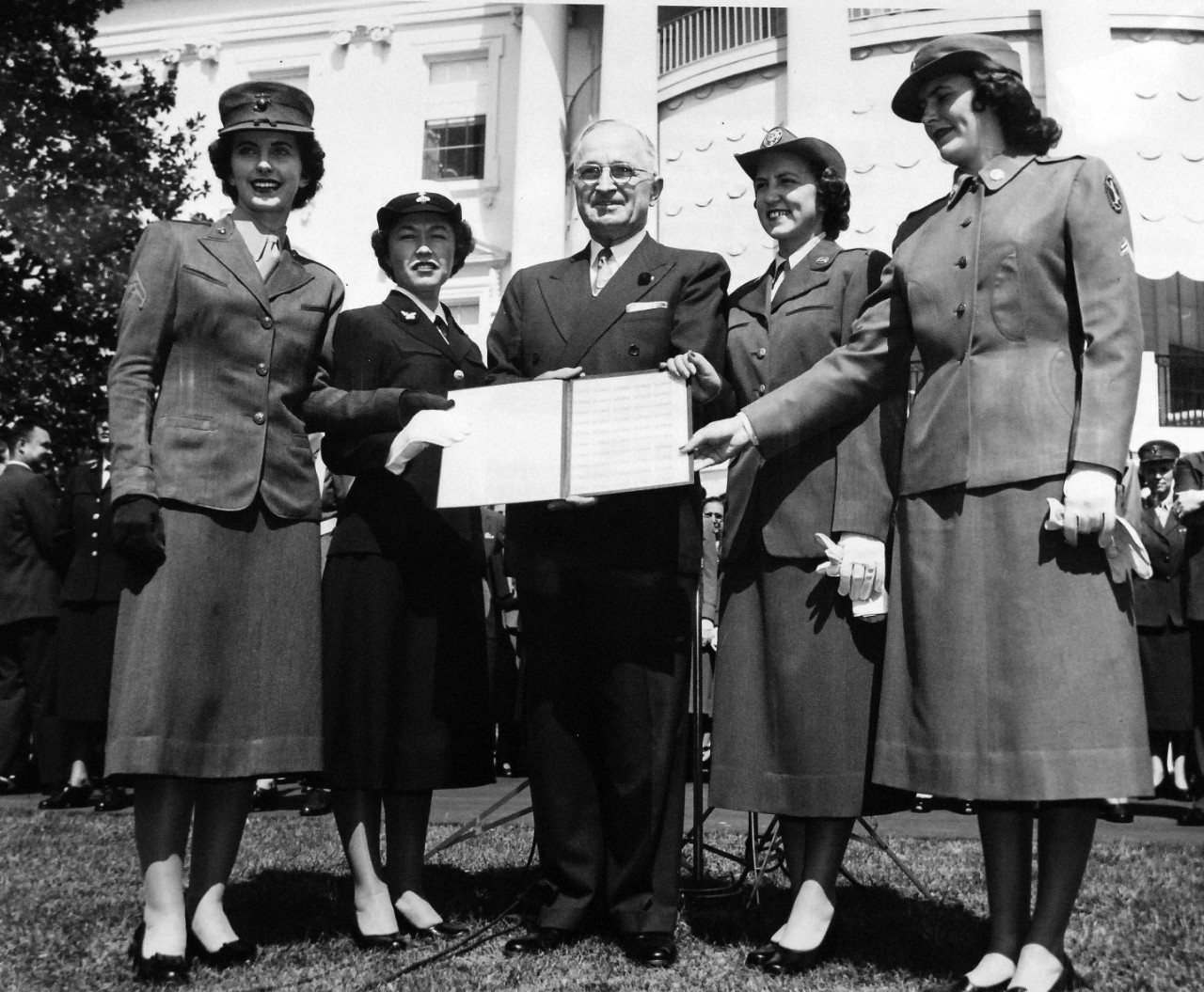Progressing Toward Equity and Inclusion:
The 75th Anniversary of the Women’s Armed Services Integration Act
INTRODUCTION
The Women Armed Forces Integration Act gave women permanent status in the armed forces with restrictions. Examples of those limitations include the following:
______________________________________________
RESTRICTION
Women can compose no more than 2% of the force.
RESTRICTION REMOVED
President Lyndon B. Johnson signed Public Law 90-130 eliminating the 2% limitation on 7 November 1967.
2023
Women constitute 21% of total naval force:
Officers: 69,426
Enlisted: 312,582
Total: 382,008*
__________________________________
RESTRICTION
Only one woman line officer in the rank of 0-6 (equivalent of a captain in the Navy).
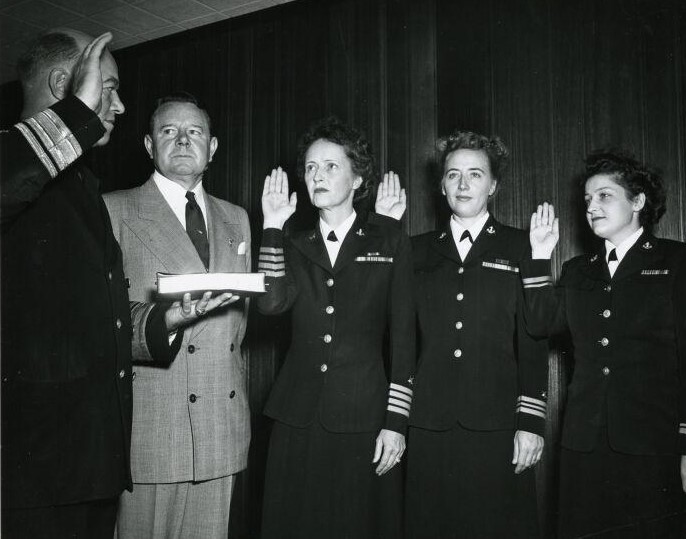
Rear Admiral George L. Russell (far left) administers the oath of office to the first women officers: Captain Joy B. Hancock (third from the left), Lieutenant Commander Winifred R. Quick (fourth from the left), Lieutenant (j.g.) Betty Rae Tennant (far right). Secretary of the Navy John L. Sullivan (second from left) attended the ceremony. (Arthur and Elizabeth Schlesinger Library on the History of Women in America, Radcliffe Institute for Advanced Study, Harvard University)
RESTRICTION REMOVED
President Lyndon B. Johnson signed Public Law 90-130 removing the promotion and retirement restrictions on women officers on 7 November 1967.
Arlene Duerk appointed to flag rank and assigned as the director of the Navy Nurse Corps on 1 June 1972.
Fran McKee, first line officer appointed to flag rank on 1 June 1976
Roberta L. Hazard, first female board-selected admiral in December 1984
Lillian Fishburne, first African American woman promoted to flag rank on 1 February 1998
2023
There are 22 female admirals among the 266 admirals in the U.S. Navy.*
__________________________
RESTRICTION
Women prevented from serving in combat forces and on combat ships.
RESTRICTION REMOVED
Secretary of Defense Les Aspin recommended that Congress amend the Combat Exclusion Law to allow women to serve on combatant ships in 1993. This proved a pivotal change for women aviators who could not compete with their male carrier-qualified peers and qualified them for key assignments.
Maureen A. Farren, distinguished herself as the first woman to command a combatant ship, Mount Vernon (LSD-39), on 10 June 1998.
Michelle J. Howard became the second woman and the first African American to command a ship, Mount Rushmore (LSD-47), on 9 March 1999.
Secretary of Defense Ashton B. Carter removed the last combat restrictions on women on 3 December 2015.
2023
Women can serve in any job for which they qualify.
For example, 13 women have been selected for Special Warfare Combatant-Craft training since 2015. One of them became the Navy’s first female Naval Special Warfare operator (i.e., SEAL) in July 2021.
__________________________________
RESTRICTION
Pregnant women and those who gained dependents by adoption or becoming a stepmother had to leave the service.
RESTRICTION REMOVED
Military women took their fight to court.
Ruth Bader Ginsburg, head of the Women’s Rights Project at the American Civil Liberties Union, served as the lawyer for several women suing the Department of Defense for its discriminating policies.
Seaman Anna Flores, an unmarried pregnant woman, miscarried. Her commanding officer proceeded with her discharge in 1970. Flores filed suit in U.S. District Court in Pensacola, Florida, to prevent the Navy from discharging her.
The court decided that the Navy was unconstitutionally discriminating against women by discharging them for becoming pregnant while not charging the male sailors who impregnated them.
The Department of Defense allowed pregnant women to remain in service in 1976.
—Dr. Regina T. Akers, Public History and Education Section, Histories and Archive Division
___________________________
Notes
*This data was provided directly to the author by the Chief of Navy Personnel, Public Affairs Office.
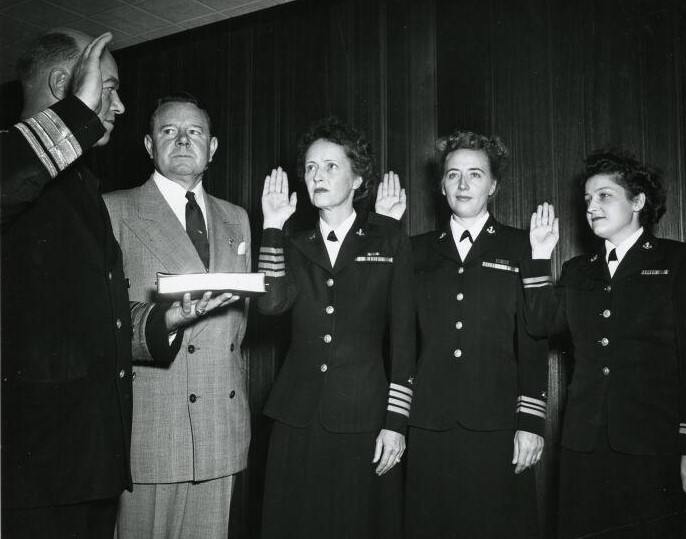
Rear Admiral George L. Russell (far left) administers the oath of office to the first women officers, 15 October 1948. (Arthur and Elizabeth Schlesinger Library on the History of Women in America, Radcliffe Institute for Advanced Study, Harvard University)
Select Sources
Primary Sources
Public Law No. 80-625, Women's Armed Services Integration Act of 1948, 62 Stat. 35. 12 June 1948.
Pub. L. No. 90-130, 81 Stat. 374. 8 November 1967.
Johnson, Lyndon B. “Remarks Upon Signing Bill Providing Equal Opportunity in Promotions for Women in the Armed Forces.” The American Presidency Project at UC Santa Barbara. Accessed 10 May 2023.
Secondary Sources
Brown, Betty M. “Women Who Dared: A Qualitative Study of the Experiences of Retired Women Flag and General Officers.” Ed.D. dissertation, University of Florida at Sarasota, 2006.
Ebbert, Jean, and Marie-Beth Hall. Crossed Currents, Navy Women in a Century of Change. Washington, DC: Brassey’s, 1999.
Godson, Susan H. Serving Proudly, A History of Women in the U.S. Navy. Annapolis, MD: Naval Institute Press, 2001.
Hancock, Joy Bright. Lady in the Navy, A Personal Reminiscence. Annapolis, MD: U.S. Naval Institute, 2002, originally published in 1972.
Huner, Brittany. “The Future of Womanpower: Women’s Military Corps After the War.” 2 August 2021.
Iskra, Darlene M. “Breaking through the ‘Brass’ Ceiling: Elite Military Women’s Strategies for Success.” Ph.D. dissertation, University of Maryland, 2007.
Murnane, Linda S. “Legal Impediments to Service: Women in the Military and the Rule of Law,” Duke Journal of Gender Law and Policy 14, no. 2 (2007): 1061–96.
Roth, Tanya L. Her Cold War, Women in the U.S. Military, 1945–1980. University of North Carolina Press, 2021.
Walker, Natalie. “Truman and Women’s Rights.” Truman Library Institute. 1 March 2021.
Whitte, Jacqueline E. “Yeah, Let’s Let Women In: Her Cold War.” War Room (podcast). 18 June 2022.
Vergun, David. “Military Celebrates Women’s History Month.” Department of Defense News. 10 March 2023.

